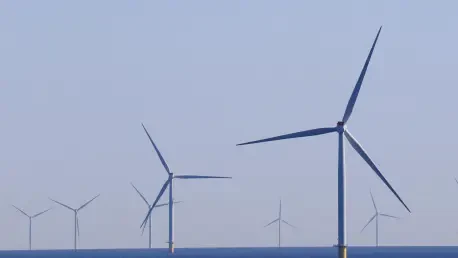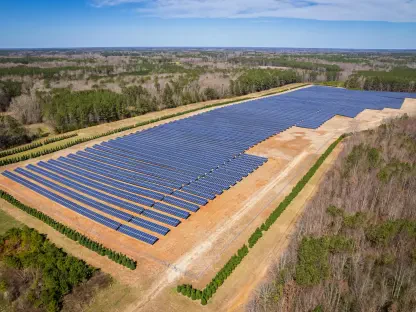In the quest for a sustainable future, the United Kingdom stands at a critical juncture with the recent approval of the Berwick Bank offshore wind farm by the Scottish Government, a project poised to become the largest of its kind in the nation, located roughly 38 kilometers off the coast of St Abbs in the North Sea. This ambitious endeavor by SSE Renewables promises a staggering capacity of 4.1 gigawatts, potentially generating up to 11.2 terawatt-hours of electricity each year. This output could power approximately 17% of UK households, equating to over 6 million homes, positioning the project as a vital pillar in the drive toward clean energy by the end of this decade. Yet, beneath the surface of this monumental step forward lies a pressing concern: the potential impact on marine wildlife, particularly seabirds, whose habitats overlap with the wind farm’s footprint. This tension between renewable energy goals and environmental preservation sets the stage for a deeper exploration of whether such large-scale projects can truly coexist with nature’s delicate balance.
A Milestone for Renewable Energy
The approval of Berwick Bank marks a significant achievement in the UK’s renewable energy landscape, reflecting a determined push toward net zero emissions and enhanced energy security. With a capacity that dwarfs many existing offshore wind farms, the project is expected to play a pivotal role in the nation’s Clean Power 2030 mission. Deputy First Minister of Scotland, Kate Forbes, has highlighted the wind farm’s importance in fostering a green economy, while SSE Renewables’ managing director, Stephen Wheeler, emphasized its potential to deliver affordable, domestically produced clean energy. Strategically connected to the grid in East Lothian and Northumberland, the wind farm is set to bolster the UK’s capacity to meet growing energy demands sustainably. This development is not just about numbers; it represents a transformative shift in how energy is sourced, reducing reliance on fossil fuels and paving the way for a cleaner, more resilient future for millions across the region.
Beyond its immediate energy contributions, Berwick Bank symbolizes a broader commitment to innovation and collaboration in the renewable sector. The project, which evolved from two separate proposals into a unified plan after extensive consultations, demonstrates the value of stakeholder engagement in overcoming complex challenges. Over a decade in the making, the wind farm’s journey to approval under Section 36 consent for its main offshore array in the outer Firth of Forth underscores the meticulous planning required for such initiatives. The Scottish Government’s green light, following a 31-month evaluation, signals confidence in the project’s ability to align with national decarbonization goals. However, the path forward hinges on securing a contract under the UK’s Contracts for Difference scheme and a final investment decision by SSE Renewables, critical steps that will determine the project’s timeline and ultimate impact on the energy grid.
The Environmental Dilemma
While the promise of clean energy is undeniable, the environmental implications of Berwick Bank have sparked intense debate, particularly concerning its impact on seabird populations. The wind farm’s location near significant colonies, such as Bass Rock—home to the world’s largest population of northern gannets—has raised serious alarms among conservationists. The Royal Society for the Protection of Birds (RSPB) has warned that the project could lead to the deaths of tens of thousands of seabirds, including kittiwakes, puffins, and gannets, over its operational lifetime. Such losses could exacerbate already troubling declines in these species, threatening the biodiversity of the North Sea ecosystem. To mitigate these risks, the Scottish Government has mandated a comprehensive seabird compensation plan, requiring SSE Renewables to implement protective measures before construction can commence, highlighting the gravity of the environmental stakes involved.
Opposition from conservation groups like RSPB Scotland has been vocal and unwavering, with director Anne McCall describing the approval as a devastating blow to seabird conservation. The concern centers on the potential for turbines to disrupt flight paths and breeding patterns, posing lethal risks to these vulnerable populations. This perspective casts a shadow over the project’s green credentials, framing it as a potential ecological catastrophe rather than a triumph of sustainability. The tension between advancing renewable infrastructure and safeguarding natural habitats is a recurring challenge in the global shift to clean energy, and Berwick Bank serves as a stark case study of this conflict. The mandated compensation measures, while a step toward mitigation, are seen by critics as insufficient to fully address the scale of the potential harm, leaving open questions about the long-term consequences for marine wildlife in the region.
Striking a Delicate Balance
The saga of Berwick Bank encapsulates the intricate dance between progress and preservation, a dynamic that defines many modern infrastructure projects. On one side, the wind farm stands as a beacon of hope for a low-carbon future, promising substantial contributions to energy security and climate goals with its massive output potential. On the other, it poses undeniable risks to the fragile ecosystems of the North Sea, particularly to seabird species already under pressure from various environmental stressors. The Scottish Government’s approach—approving the project with stringent conditions—reflects an attempt to navigate these competing priorities, working alongside stakeholders from fishing and conservation communities to find common ground. Yet, the deep divide between industry ambitions and environmental advocacy suggests that consensus remains elusive, and the true cost to biodiversity may only become clear over time.
Looking back, the approval process for Berwick Bank revealed both the promise and the pitfalls of large-scale renewable initiatives. The rigorous 31-month evaluation period underscored the complexity of aligning energy needs with ecological responsibilities, while the mandated safeguards aimed to lessen the impact on marine life. The fierce opposition from conservationists served as a reminder that technological advancements must be measured against their environmental footprint. As attention turned to the next phases, the focus shifted to securing financial backing and rigorously implementing the seabird compensation plan. These steps were seen as essential to ensuring that the project did not come at an irreparable cost to wildlife, offering a blueprint for how future developments might navigate similar challenges. The story of Berwick Bank ultimately became a pivotal chapter in the UK’s journey toward sustainability, testing the nation’s resolve to harmonize clean energy aspirations with the imperative to protect its natural heritage.









